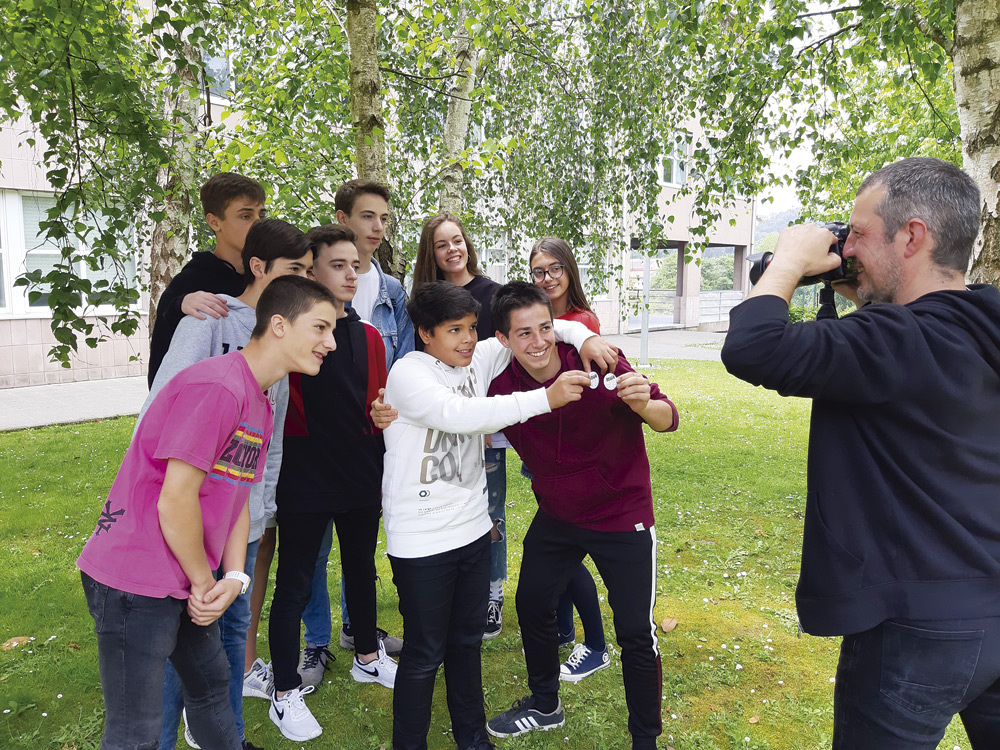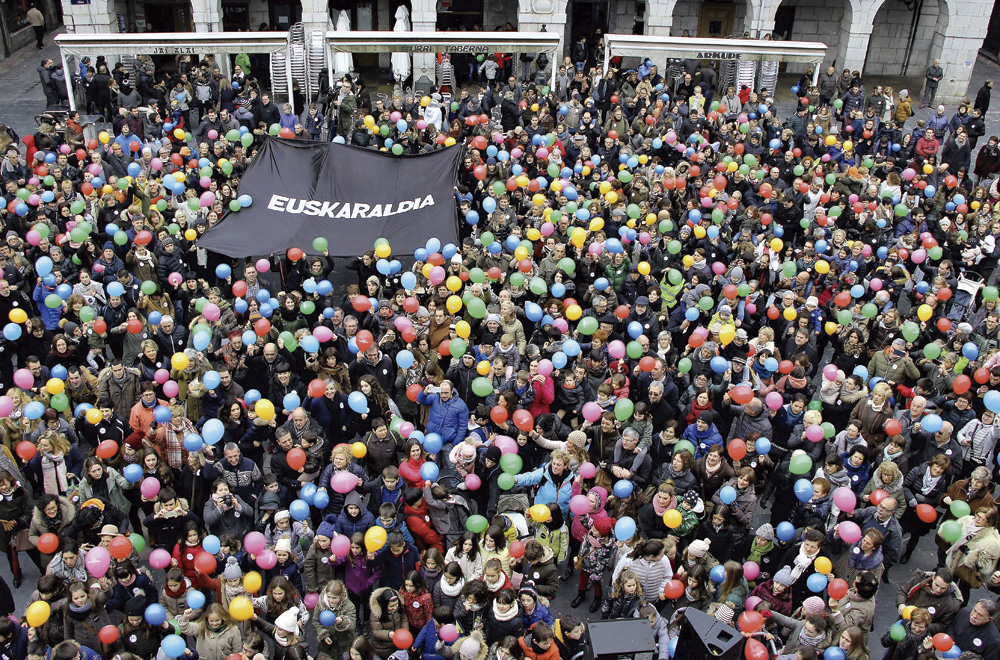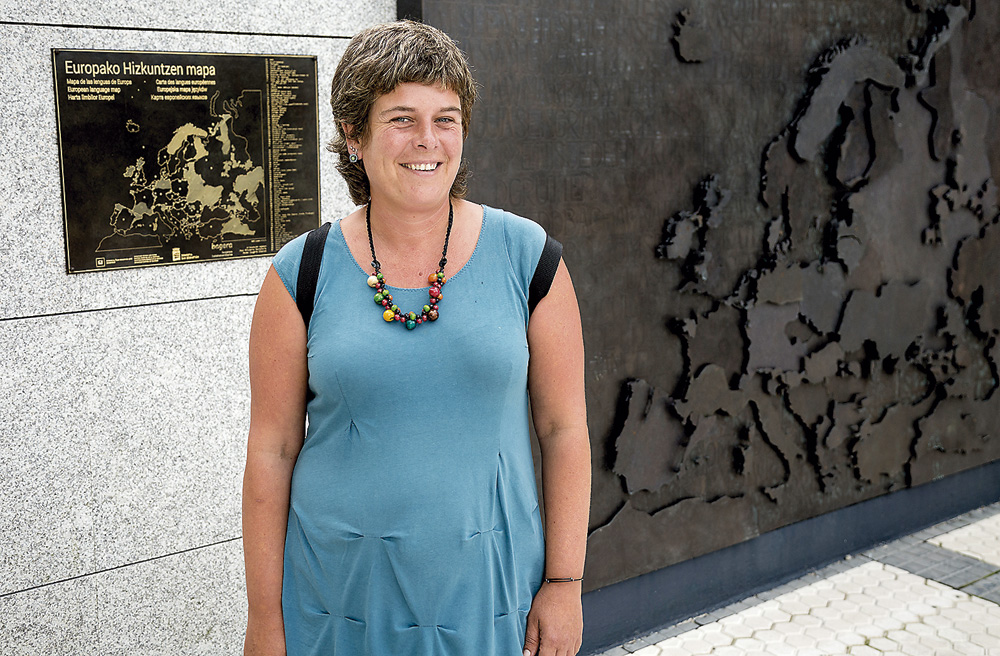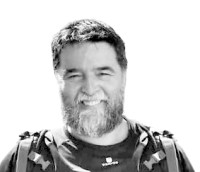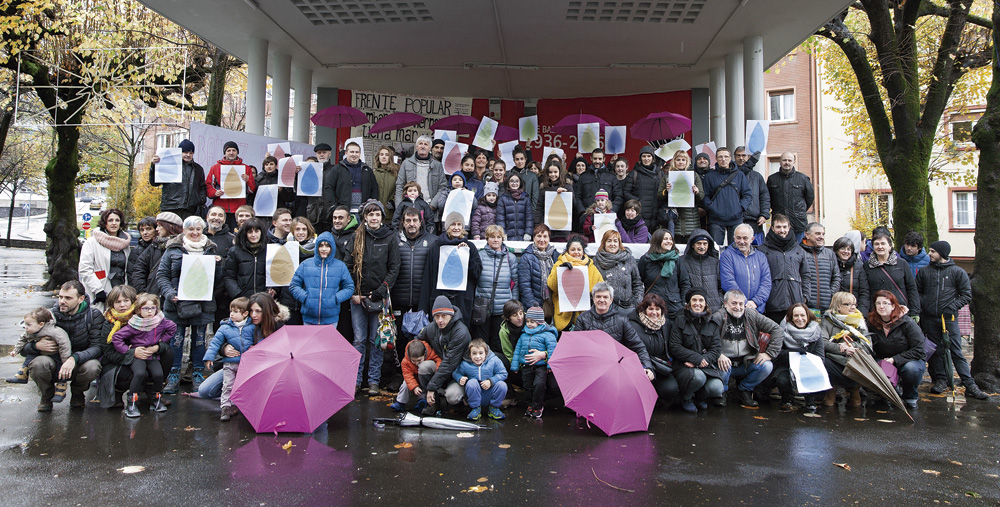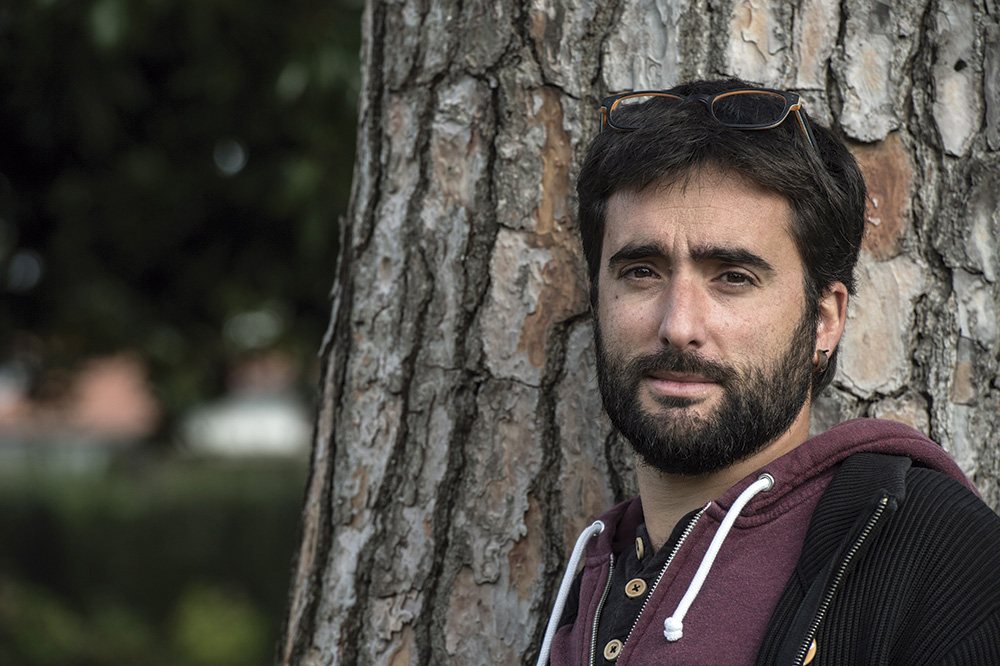Success and expansion of "Egia Euskaraz style"
- It started in the Egia neighborhood of San Sebastian. Next, the test was carried out by those close to Añorga and the Pirates of San Sebastián. More of the “Truth in Basque Style” came: Hernani, Lasarte-Oria, Agurain, Astigarraga, Sierra... Basque actors from all over the country expressed the same sentiment: the need to get out of the festivities and try out strategies to live in Basque.

Aitziber Gurueaga is a member of “Because We Want to Live in Truth in Basque”. The members of the Basque Committee felt that there was a mass of people who wanted to live in Basque in the Egia neighborhood of San Sebastián. They had one thing in mind: “We thought it was good to organize chocolate dinners for the Basque language, but it was time to take another important leap. It was a big leap, from cultural actions to a point of activism of this kind. We also had in mind the message of the race, of empowerment. It seemed that the time had come to do something like this and that there was a chance to do it.”
The evaluation is very good, it can be said that the laboratory experiment went very well. After trying to live in Basque for a week, the participants shared their feelings, accomplishments and experiences. Cruz thought, “This is a bomb.” The True Ones repeated the question of appropriation a lot, “although we always say that we want to live in Basque, in the initiative many realized how easily we go to the other language. It was very important for people to realize that. We have a chance to change the language.”
Realizing the success of the initiative, similar dynamics were carried out in several locations in 2016. For Cruceaga, the Truth conveyed something positive, envying the others. Some actors in other localities were surprised by the public’s acceptance of the campaign and the number of participants. The most beautiful thing, in Cruceaga’s opinion, is that those who came next did not simply copy the True One, but have refined it and adapted it to him.
In 2017 they will take a break, since it is Corrida, but they are clear that in 2018 they will follow this line. Aitziber Gurueaga is also an employee of the Basque association Bagera in San Sebastián. The Basque association Egia, Añorgan and Semana Magna Pirate worked as an incentive to carry out this initiative, and in 2017 they planned to continue inciting in the other neighborhoods of the capital of Gipuzkoa.
What is “True English Style”?
On November 28, 2015, Egia was announced by the neighbors. From the 8th of January to the 26th of February 2016 the agents or groups and from the 26th of February to the 4th of March the individuals carried out the initiative We Want to Live in Truth for a week. The Egia Euskaraz Committee was the driving force behind the initiative, and for them, Lutxo Egia was the ‘culprit’ of the quality of the initiative. In his performance, the artist spent a whole month talking exclusively in Basque and wrote reflections every day in the newspaper Berria.
Aitziber Gurueaga (The Truth District): “We thought it was good to organize chocolate dinners for the Basque language, but it was time to take another important leap. It was a big leap, from cultural actions to a point of activism like this”
The True Ones celebrate the International Day of the Basque Language every year, as well as the Day of the Truth in the Basque Language every two years (when I do not run). But the Truth Commission wanted to go further. Thus, for seven weeks the agents (groups and associations of the neighborhood) were beaten alternately and talked about the Basque fire. They also had to deal with those who say they don’t understand Basque. He could be a salesman, a relative or a member of the dance team, who did not speak Basque, but was able to understand everything. However, in such cases there is a tendency to do so in Spanish. They had a chance to break that inertia that week. The Basques were the target and for them they prepared the TELP workshop. When obstacles arise to be able to do it in Basque in the course, they learned what attitude to take and how to act.
They used notebooks to write good experiences, bad experiences, or reflections. In addition to the notebook, the pin or badge Because We Want to Live in Basque was also placed on the brooch to be identified.
Hernanin “Speak Spanish”
December 3rd, the Day of the Basque Country, was taken as an excuse by the Hernanians. They prepared a two-month challenge. The goal was for as many citizens and associations as possible to live in Basque, and they made a commitment for at least a week. At home, in the workplace, in the shop, in the sports team, in the bar... they tried to do it in Basque. Individuals and associations rotated from 15 October to 26 November.
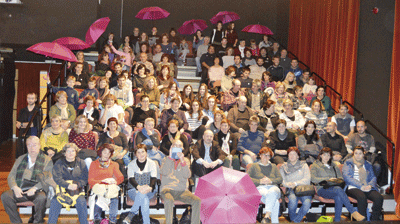
Photo by: Kronika.eus.
The organizers had several goals and explained this in their Facebook post: “We want to shake people’s consciences, make people realize that changing our habits is not so difficult; that more people than we think know or understand Basque around us; that if we do what we know, those who do not know will learn more easily and have a greater chance of using Basque. At the end of the day, let the people know that with this small gesture we can make a big change in Hernani.”
At the time of closing this article they did not have an official rating, but Joan Mari Larrart, who was part of the organizing team, offered us good impressions of the first blow. Here's what he said: “On the one hand we have to highlight the reception. When we went to tell them about the initiative they welcomed associations, agents, etc. and many agents, around 1,800 people, participated. Before the six-week rounds we organized four conferences on Basque language rights, in which there was a lot of participation. We noticed that in the village there was hunger or interest to address the issue. On the other hand, in the Basque language there is often the feeling that initiatives are launched, a lot of effort is made, and then the results are not seen so clearly. At least in this case, the feeling was that he had reached out to people. We heard two kinds of messages from the Basques: some said they realized that Hernani lives in Basque, and others said they thought they lived in Basque in general and that thanks to the initiative they realized how many times they have to change the language. And thirdly, the initiative also served to visualize what he is able to understand in Basque.”
Lasarte-Orian “Yes 40 days in Basque”
The challenge of running the Basque Language Marathon for 40 hours every four years was small. The marathon turned into a party “fortunately,” said Iñaki Arruti, head of the Basque Department at the Lasarte-Oria City Council, whose 40 hours of Basque were easily covered by a significant increase in Basque knowledge in the town. They wanted to take on another challenge and created “Yes 40 Days in Basque”. The actors drank from three sources to structure the initiative. On the one hand, at the beginning of 2016 they approached the Egia neighborhood of San Sebastián to see what they did. Second, they took on the research to change Aldahitz’s language habits. Third, to help cultivate the assertiveness of the language, Ferran Suay and Gemma Sanginés had the material “Get out of the closet” in their eye point.
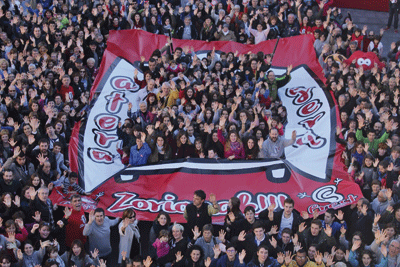
finished the initiative they left the closet. Photo by: The Chinese magazine.
They worked in the neighborhood of truth. They created roles of “palate” and “ear”, people made commitments and organized shifts for several weeks. “Ahobizudas” were Basque and made two commitments, one to make everything in Basque to the one who understands Basque and the other to make the first word in Basque to the unknown. “The ears” were able to understand Basque. It would be nice to do them in English. Both roles had identification badges.
Although they did not have a valuation made with calm, in the remainder of 2016 the balance was positive. It was attended by 2,000 people over 16 years of age, whether they were “palate” or “ear ready”. First of all, he emphasized the valuation and participation of the initiative that Arruti gave us: “One of the variables of success was that of participation. Another, I think we invented it with two roles (with the concepts of ‘palate’ and ‘ear ready’) or with the offer. I believe that these concepts came from the world of sociolinguistics and research and that we managed to socialize and communicate. We managed to communicate from an image point of view, but we also worked in relationships (schools, schools, businesses, associations, young people, EPA...) with an incredible amount of work that we have never done before. We immediately realized that the communicative preparation worked, people said, ‘How nice, how nice!’. They said this because of two things, because of the appearance of the communication campaign, but also because they felt that he was very successful in his own problem.”
They were satisfied with the participation and the quality of the participation, but Arruti wanted to add one last achievement. The local community strengthened relations. Not only because of the “Yes 40 days in Basque” initiative, in 2016 several Basque actors had anniversaries and knew that it was a unique opportunity for collaboration. Thus, the anniversaries and the pretext of the challenge, the agents of the town experienced a solid approach.
They haven’t started to think about what to do next, but last year they were hoping to receive valuable clues from two sources. On the one hand, UPV/EHU professor Pello Jauregi will present the research related to the challenge in the spring of 2017, with the opinions of 500 people who participated in the initiative, and on the other hand, the organizers asked the 2,000 participants to tell their experiences.
“75 hours in Basque” by Agurain (this 30-page report contains all the details of the project)
The elders had their “15 hours of Basque” party, but in 2016 they planned to do something else. They did not celebrate, from November 8th to 11th, they tried to do it in weekdays, daily, in Basque. The Basques were activated, the Midwayers were given explanations to adapt to the new situation, and the dialect of the town that was half asleep was lit up.
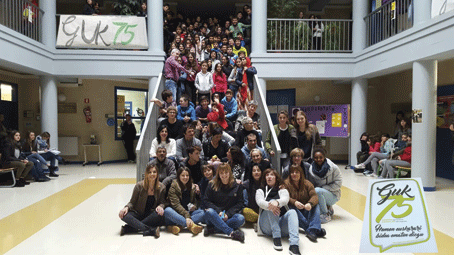
Young people and adults participated. Photo by: www.aniturri.hezkuntza.net.
Agurain has 5,000 inhabitants, over 17 years of age 3,600. 800 Basques over 17 years old. 283 were active in the campaign. So they have about 500 passive Basques in the village.
At the end of the initiative, the organizers passed the questionnaire to the participants. 201 out of 283 answered the questionnaire. Their responses help to take the initiative to the next level. You have questions and answers in the following lines.
The first question was whether they made more effort than usual to use the Basque language. 86% said yes. They were then asked if they had detected the activation of other Basques in the town and 65% said yes. Another question was where did they win new relationships. This is how they responded: 51% with shops, bars or institutions; 34% with acquaintances; 22% with those of the squad; 17% with those of the household; 17% with strangers; 9% with colleagues; and 19% did not win relationships.
Asier Lafuente is part of the organizing team and he told us: “It is worth highlighting the percentage of new relationships that were given to stores and organizations. We worked mainly in this area. What we have learned is that if you work in an area of the organization, new relationships are created.”
They were asked what effort they had made in the next question. For six months they had been proposed some new behaviors and wanted to know which ones they had used. In view of the responses they realized that there were two levels of activation. The behavior of “first word in Basque” was used by 80%, but in all other behaviors it was around 20%. For example, “I have done it in Basque with everyone” 20%; “if they answered in Basque I followed in Basque” 26%; “although I have tried not to understand Basque by gesture” 20%; “we have agreed to do it in Basque” 24%.
The answer to the last question was encouraging for the organizers. They were asked if they were willing to continue with their new behaviors. 87% said yes. This is what Lafuente says: “For us it was one of the goals of these four days, to empower people to be able to spread new behaviors, and then to follow it up.”
Astigarraga “100 to 100... 200 hours in Basque”
The initiative took place from 26 November to 3 December. Like the agents of different localities, in Astigarraga they celebrated the Day of the Basque Language on December 3, but in 2016 they focused on the neighborhood of Egia and other localities that carried out similar initiatives.
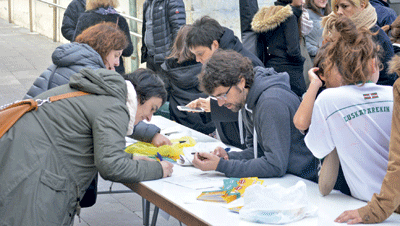
made the commitment. Photo by: Kronika.eus.
The starting point was very different. In the village, data on the use of the Basque language by children have declined in recent years and were concerned. One thing was clear: they would not influence children, but adults, who are the role models of children in the use of Basque. So, following the “Truth in Basque Style”, they prepared the initiative for adults.
The following took part in the initiative: AEK, City Council, Xaguxar Leisure Group, Mundarro Sports Association, Music School, Local Youth, Popular School and Parent Association of Popular School. Izarne Zelaia is the coordinator of the Association of Parents of the Popular School and gave us a bittersweet assessment of the initiative: “We had 447 speakers and 46 speakers. About 50 people took part in the trade. We heard everything. 447 speakers yes, but those who were really conscious and made the chip change don’t know how much. We don’t know how far we’ve come to people. Another said that there were people in the village who did not know about the initiative. Those are the negative parts. On the other hand, we noticed that although we did not reach a hundred percent in the use of Basque, people talked about it in their environment. This is the first step, to realize what behaviors each one takes in the relationships they have. Perhaps on a small or close level, but we hope that it would at least serve to stimulate reflection.”
In Arrigorraga “Yes 365!”
The population of the town is 12,000, 4,000 Basques, 3,500 almost Basques, and the use of Basque does not reach 10%. The Basque association Abarras del Pueblo organized the TELP workshop. After that came the “Yes 365!” initiative, the workshop was a stimulus. The workshop brought together people from the local dialect and individuals who couldn’t figure out how to live in Basque. The people of these two profiles completed Yes 365! Group of friends.
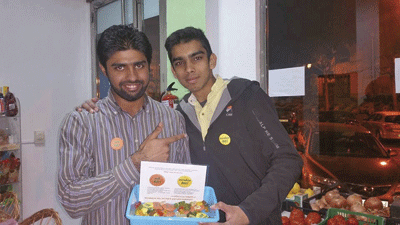
Photo by: Yes, it is 365! Group of friends.
The initiative began on November 10 and officially ended on December 3, although people continued to use identification badges afterwards. The assessment was made by Ane Arnago and Eva Meñik. Positive and less positive results were observed. They realized that the veneer to put on the brooch had been distributed impressively, but they have doubts that later on more Basque was heard in the street, Meñik and Arnau, did not notice such a difference. Instead, the bartenders told them that they had detected it. As the Basque workers of the bars or those willing to listen in Basque were identified, they realized that more people were asking in Basque. For Meñike, although he did not notice any significant changes during those days, he managed to visualize some Basques, “in the squadrons that always do in Spanish we did not know if there were Basques or not, because we never heard them in Basque. Now, as a result of the plaque, we know that such a person is Basque, and Vila is small, we all know each other.” Arnago pointed out that what they wanted to promote is an attitude rather than an initiative, which is not achieved by putting on a plate for a few days. What they managed to achieve is to reveal the subject. Meñik added: “It is fashionable to proclaim the Basque language, to be in favor of the Basque language, but that is the use of one thing and another. There are many factors to avoid using it. We'll do it little by little. It is clear that we will continue with this issue.”
Euskaraldia, EAEko instituzio nagusi guztietan PSErekin gobernatzen duen PNVk Topagunearekin izenpeturiko akordio estrategikoa da, ez nik hala esaten dudako, beraiek publikoki 2017ko Udaltopean horrela aurkeztu eta definitu zutelako baizik. Eta Euskaraldia da PNVk, bere... [+]
Guk dakigula ez dute halakorik egin, baina Alberto Irazu kazetariak euskaraz egin du elkarrizketa zuzenean Radio Euskadin, ia 20 minutuko esperimentua.
Hernaniarrek errodajea dute, eta 2018ari begira pentsatu dute ez direla udazkeneko hotzen zain egongo. Urte osoan saiatuko dira 24 orduz euskaraz egiten. Euskara Ari Du elkartea sortu berri dute horretarako.
Aurten gehiegi pentsatu beharrik ez dago, zer egingo dugu bertso saioa, ginkana, txokolate jana, mosaikoa, lipduba? Horiek ere egingo dira, baina herri dezentetako herritarrek eta euskalgintzak motorrak berotuta dituzte. Kalera aterako dira egun osoz euskaraz egiteko asmoz.
Sustatzaile nagusi Euskaltzaleen Topagunea eta Eusko Jaurlaritza ditu. Xedea 2018ko udazkenean Euskal Herriko txoko guztietan herritarren hizkuntza ohiturak aldatzeko praktikak egitea da.
Establezimenduen zerrenda egin dute euskaraz aritzeko duten gaitasunaren arabera. Udazkenean, beste herri askotan bezala, derioztarrak “ahobizi” eta “belarriprest” bilakatuko dira.
Errenteria, Oiartzun, Pasaia eta Lezon 110 lagunek konpromisoak hartu dituzte euskara erabiltzeko.
Baiona, Angelu eta Miarritze artean egingo dute ekimena, azaroaren 27tik abenduaren 3ra bitartean. 450 hiztun mobilizatu nahi ditu BAM ekimenak. Antolatzaileek euskaraz “naturaltasunez eta alaitasunez” aritzeko deia egin dute.
Ekimen berria du Aiaraldeko Euskalgintza Kontseiluak esku artean: 1.000 ahobizi eta 5.000 belarriprest “armairutik" ateratzea. Euskaraz hitz egiten dakitenen eta hizkuntza ulertzen dutenen arteko zubiak eraikitzea da egitasmoaren xedea. Astebeteko lau txanda egingo... [+]








